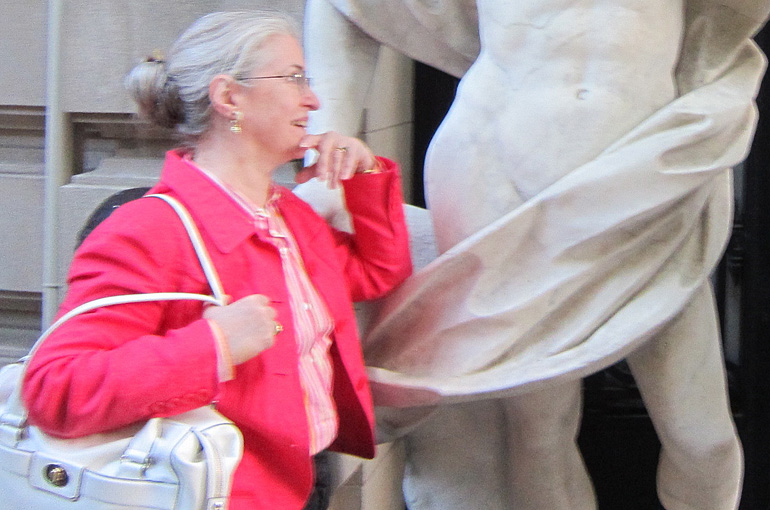
Patrick McGilligan’s book, Alfred Hitchcock: A Life in Darkness and Light, has been on my bookshelves since it came out, ten years ago, but I’ve never cracked it, largely for reasons alluded to in connection with Stephen Rebello’s book about Psycho, in an entry last week. You can say that I’m cracking it now because the Rebello book, if it didn’t float me over the déja vu that seems to accompany reading about Hitchcock, at least got me to watch Psycho with fresh eyes, and that, in turn, made me eager to see Frenzy again. I’ve liked Frenzy since it came out, in 1972, and long regarded it as Hitchcock’s last really great movie. Watching it over the weekend made me want to read something about it — perhaps it might identify the Oxford Street alleyway in which Brenda Blaney’s marriage bureau is located — so I pulled down McGilligan. I didn’t find out anything about the alleyway, but I found myself, when Frenzy was over, reading about Strangers on a Train, and what McGilligan had to say made me want to see it again right away, so I did.
Frenzy was something of a disappointment, largely because it lacks what made Psycho so appealing to me when I watched it last week: dramatic, “theatrical” conversations. Hitchcock’s films are studded with them. Their pace is generally, and very ironically, restrained; the drama comes not so much from the dialogue, and certainly not from the actors’ expressions, as from the lighting: like any magician, Hitchcock understood that lighting can make even familiar inanimate objects intriguing. One of my favorite scenes of this kind is the library scene in North By Northwest, in which Roger Thornhill’s uncomprehending but apparently bottomless vulnerability is at odds with the room’s handsome, somewhat staid appointments. Three be-suited gentleman in a paneled room overlooking a garden — who can think of violence in such a setting? The dialogue, too, is hardly that of rough guys spoiling for a fight, but it is loaded with malice. (“Your very next role.”) Last week, I wrote about the powerful scenes that Norman Bates has with, first, Marion Crane, and then, with Detective Arbogast, but missed the significant point that these are the two people whom Norman is going to kill as the action unfolds.
There are no such scenes in Frenzy. One might argue that Bob Rusk’s visit to Brenda Blaney’s office constitutes one, but while it might begin as one it soon becomes something very different — something without precedent in Hitchcock’s work. The library scene in North By Northwest ends with a bit of manhandling, as Roger is forced to drink bourbon, but the ensuing violence occurs on a North Shore road, with Roger, rolling drunk, at the wheel of a stolen car. (Ah, those scenic oceanside drives along the cliffs of Glen Cove and Oyster Bay — what a shame they don’t exist.) At the risk of being precious, I might argue that the library scene is the cavatina, and the driving scene the cabaletta, of a bel canto aria of Hitchcock’s operatic style. In Frenzy, the two bits are merged, and no one, seeing the film a second time, can imagine that what is in fact an assault, rape, and strangulation scene is going to depend on creative lighting for its effects. There is, in short, no false calm, or very little of it. (Bob and Brenda lose their tempers pretty quickly.)
The other powerful “scene” also features Bob Rusk, but he is alone with sacks of potatoes and a corpse: there is no conversation. It is an action scene, slowed down to a crawl — something else that Hitchcock knew how to do very well. But the bulk of the movie is spent on the run. Richard Blaney, the intemperate fighter pilot who is wrongly thought to be the necktie murderer, can’t sustain conversations; even his monologues, his attempts at apology, soon degenerate into reproachful vituperation. It is therefore interesting to read what McGilligan has to say about the making of the movie. Finch, it seems, had very imprudently remarked to reporters that Hitchcock was “past his prime” and that he would probably improvise his lines (the dialogue is pointedly vétuste).
In subtle ways and worse, Hitchcock never let Finch forget this transgression. More than once he pointedly stopped the actor before a take, asking if Finch was satisfied with his lines; when Finch once dared to suggest a minor word chance, Hitchcock ceremoniously halted the photography until Anthony Shaffer [the screenwriter] could be found and consulted. Whenever Finch strayed so much as a hem or haw, the script girl corrected him sharply.
Hitchcock gave Finch no warmth or support on the set, so the actor always remained off balance — just as Blaney is throughout the story.
It is well established by now that Hitchcock’s feelings about particular actors often determined the performances that he elicited from them; it is clear that Psycho is a powerful movie at least in part because Hitchcock really liked Janet Leigh and Anthony Perkins. It’s also clear (McGilligan says as much) that Vertigo owes much of its punch to Judy Barton’s visceral desperation at being trapped in her various roles — a despair that mirrored Kim Novak’s fear, fed by the director’s impatience with her, that she didn’t know what she was supposed to be doing. Eva Marie Saint, conversely, has said that she felt both liberated and protected after Hitchcock personally took her to Bergdorf Goodman to buy her outfits for North By Northwest. The chemistry between director and actor was arguably a leading variable in the shaping of Hitchcock’s films, a remarkable deviation from his dogged professionalism. Jon Finch was never interestingly lighted in Frenzy.
***
Strangers on a Train has quite a few banked scenes. (I’m going to try “banked” as a descriptor: I’m thinking of coals glowing brightly enough to cast interesting shadows.) Several of them are peppered by Patricia Hitchcock’s impish impersonation (if that is what it is) of a proper young lady who knows much more about the world than is altogether suitable. Those scenes are also clouded by the performance of Ruth Roman, which teeters on the edgy of soap-opera excess. Her manner of picking up the telephone and cradling the mouthpiece as if she were caressing her fiancé is almost camp, particular in contrast with the ironbound restraint of Leo G Carroll as her father. Laura Elliott (a/k/a Kasey Rogers), playing Miriam, the funseeking opportunist who stands between Roman’s character and Guy Haines, the tennis ace played by Farley Granger, is much more interesting to watch. Marion Lorne, whom Hitchcock cast before he even had a script, manages to give her silly, vague character, the villain’s mother, a weird but unforgettable passive monstrosity, and her two scenes are nicely banked. The second one would be better if it did not fade out on Ruth Roman’s “perplexed” expression. These overreactions are almost, but not quite, offset by Roman’s more active scenes, which she handled creditably.
Granger and Robert Walker (playing Bruno Anthony, the sociopathic socialite) have the longest banked scene, of course; it’s the one in which they meet and cease to be strangers on a train — with a vengeance. McGilligan tells us that Hitchcock wanted William Holden for Guy Haines; I think that he’s very lucky that the studio insisted on Granger. I can’t imagine Holden sitting through drinks and lunch with the twisted flirtatiousness that Walker summons. Granger makes it clear that what keeps Guy from parting company with the frequently offensive Bruno is his own self-doubt, in addition, of course, to Guy’s need to be nice to people. Walker gives us a Bruno who is captivating when his eyes are twinkling on the screen but repellent when they’re not; if you ask me, he transcends his character’s creepiness. Bruno is deadly but charming.
Both Frenzy and Strangers are “on-the-run” movies, as McGilligan calls them. Watching them side by side, I found the older film to be sleek and accomplished, with a fantastically well-structured climax. (The deranged carousel at the end, tilting off its rocker, has the feel of a very precocious special effect.) But it is not as disturbing as Frenzy. Miriam Haines may not deserve to die (no one does), but she’s an almost completely unsympathetic figure. Brenda Blaney (Barbara Leigh-Hunt) and Babs Milligan (Anna Massey) are just the opposite: warm and appealing and genially above reproach. But the respite scenes in Frenzy don’t count as banked, because they all take place in the detective’s flat, as Vivien Merchant inflicts nouvelle cuisine — offal cooking would be more like it — on sweet Alec McCowen. There are many clever set-ups in these scenes, but no interesting lighting; the dinners are sardonic intermezzos, pauses in the chase; neither the detective nor his wife, certainly, is on the run. (That it might be said that the detective is on the run from his wife’s culinary ambitions only proves the point.)
And yet Frenzy falls short in the display of Hitchcock’s trademark juxtapositions of the everyday and the extraordinary. The everyday settings in Strangers on a Train, whether they be rail cars or reception rooms or the National Gallery or an amusement park, are all transformed into chambers of horror by Bruno Anthony’s prowling. And he doesn’t need to show up at Forest Hills in order to make Guy’s climactic match a palpitating event. As McGilligan says, this part of the climax involves multiple games. Guy wants to win the match, of course, but he also wants to win quickly, so that he can get to Metcalf in plenty of time to foil Bruno. He also has to play a game of evading the police who are tailing him. Bruno, meanwhile, has a game of his own, and it is an extraordinary example of Hitchcock’s artistry. Bruno is the bad guy, and the cigarette lighter that he’s carrying is meant to implicate Guy in his wife’s murder, and yet, when Bruno drops the lighter in the sewer and then struggles to retrieve it, stretching his arm down into the disgusting muck of a drain, our sympathies are, for the moment, entirely with him.
Twenty years later, we’re not quite so eager for Bob Rusk to retrieve his stickpin — not if it involves breaking poor dead Babs’s fingers.


